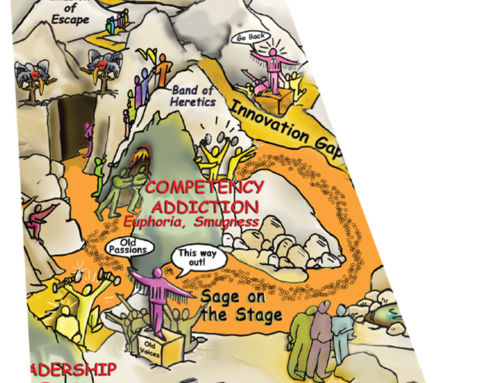Organizational structures and mass employment has been eroded in the Badlands over the past decade.
Eight big shifts are underway, driven by major structural shifts to the economy, business model innovations, and the dramatic changes in technology. Together they are creating the new future of work. As these shifts complete their evolution over the next decade, a dramatically different landscape will be in place that will give rise to new forms, functions and capabilities.
The first four of these big shifts, all rapidly moving toward completion, are discussed here:
1. Employee to Entrepreneur
The older industrial models of work held clearly defined roles between the employee and the employer that matched the mass production of that era. The employer created the work and the employee completed it for a clearly defined package of wages and benefits. That was the social bargain for work.
As the knowledge economy has become dominant, the control of work has shifted from the organization to the individual. Increasingly, educated workers are not seeking the employment structures of the past but are remaining entrepreneurs, independent from any one or few organizations. Their careers become one of a sole proprietor selling his/her skills and knowledge in the marketplace independently and morphing their profiles in the alchemy of the marketplace’s serial opportunities.
2. Career Ladder to Experience Portfolio
No longer will workers look externally to other individuals and companies for a pre-defined career ladder. Another big shift in work is the drive of workers to create a compelling experience portfolio so they can shop around in the marketplace for interesting work. It used to be that workers were focused on joining a company and climbing up the career ladder to get to higher positions. Those days are gone. Knowledge workers will seek temporary experiences that build their portfolio and support their individual aspirations and goals. This experience portfolio will then clearly define to potential employers how their skill set can be contracted for a specific opportunity that they have need to fill.
3. Physical to Digital Infrastructure
As globalization grows, physical infrastructure becomes less important. New connective technologies make work, the sharing of ideas, and innovation, easy, despite distance, culture and time. Gains in productivity are surpassing what was previously possible with everyone working at the same time and in the same place. Virtual work, once a social innovation that felt awkward to the early adopters, has become commonplace. Workers feel each other’s co-presence and availability, and sense camaraderie. Social networking tools have become the ‘virtual water cooler.’
Although some physical infrastructure will always be necessary and serve an essential purpose, the ability to leverage digital infrastructure enables new, more effective ways of working. And that provides productivity, social and market penetration gains here-to-fore unknown.
4. Brick-and-Mortar Organizations to Social Networks
Organizations developed into defined hierarchical structures with lots of brick and mortar in response to mass manufacturing. As globalization of the economy diffused with the dis-aggregation of work and rapid innovation, disruptive shifts took hold under the development of a cluster economy. Companies have shifted to network-style organizational structures, more resembling fishnets in structure.
As the manufacturing economy gave way to the knowledge economy, social networks of knowledge workers are becoming the key infrastructure of work. These burgeoning social networks cross boundaries, with individuals from different organizations and industries interacting and weaving them together. Social networks have become both the receptacle, and opportunity, for companies and individuals to create valuable and mutually beneficial Velcro relationships that get work and innovation done. This shift means that it will be increasingly common for people to note what social networks they belong to, rather than just what companies they have worked for, with a corresponding shift in prestige towards social networks.
These first four disruptive shifts touch on many social, economic, and technical issues, but there are more. Access the final 4 disruptive shifts here to find out how they will enable different aspects the future of work.



